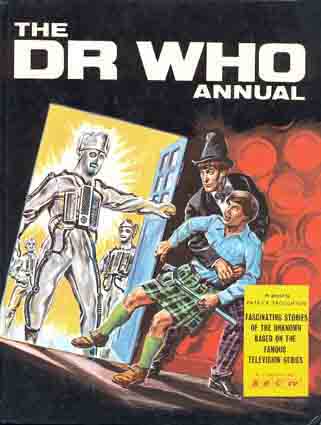The 1969 Annual

|
|
World Distributors The 1969 Annual |

|
| Illustrators | Walter Howarth and David Brian |  |
| Published | 1968 |
| Starring the second Doctor, Polly, Jamie and Victoria. |
A Review by Finn Clark 4/2/04
Slightly weaker than last year, but more consistent. The 1969 annual contains the usual mix of stories, comic strips, games and non-fiction articles, so the stories have shrunk despite a slightly smaller typeface (1000 words per page instead of 800). Nevertheless this book squeezes in ten short stories, two comic strips and fifteen space-fillers of various kinds. That's a pretty packed collection.
The second Troughton annual is the one with a cover painting of Cybermen breaking into the TARDIS and Jamie holding a Dalek's claw arm, not to mention a couple of Yeti in the illustrations elsewhere. (None of these creatures appear in any of the stories.) The art looks nice, though the 'scary' aliens in Lords of the Galaxy seem to belong in Looney Tunes. Dr. Who, Jamie and Victoria are drawn attractively but in such a stylised fashion that they're unrecognisable as the actual actors, to the point where one of the comic strips (Freedom by Fire) decided to call them Dr. Who, Jamie and Polly. It's an understandable mistake. David Brian's Victoria looks more like Anneke Wills than his Polly did!
The stories are the usual mixed assortment, albeit this year with plenty of sixties surrealism. The collection gets violently weird with Mastermind of Space (one of the two rewrites of last year's The Dream Masters) and The Celestial Toyshop, which I thought were great. Mastermind of Space gives the "brainwashed Dr. Who and friends" a humanistic twist that's very Star Trek but rather sweet anyway. You certainly can't accuse it of thinking small. And then The Celestial Toyshop isn't a Toymaker story but instead an infinite regression of dollhouses in a child's playroom that's, like, totally cosmic, man. It's almost Lovecraftian at times (if illustrated by Paul Crompton from Tom Baker's annuals this would have been a horror classic) and its last line is the work of drugs. What its 1968 target audience thought I have no idea:
"The Doctor slept for hours and not a dream disturbed him. That strange and utterly unearthly place where the dimensions had overlapped, at last, ceased to trouble him. But it left behind a tiny, nebulous regret that he could never afterwards understand. Eden is lost every moment of our lives."Atoms Infinite is a six-page comic strip so demented that it's beyond my ability to describe. The TARDIS shrinks to explore "inner space", becomes the size of a sub-atomic particle and discovers teardrop people hanging from palm trees in the Uranium Universe. Things then get even weirder. The author is trying to write an anti-nuclear polemic, but the idea that anyone could think this was a serious message story only adds to its Bizarro World insanity. Not just the loopiest story in this annual but a candidate for "loopiest story ever written", and not just in Doctor Who.
The text story The Microtron Men is another treatment of the same idea, but it makes Atoms Infinite look coherent and well-plotted.
Then we have the Big Concept stories in which strange things happened to Earth. One example is Planet from Nowhere, though underneath it's a simple morality tale. (According to Dr. Who the Salonian planet, Axal, is actually Earth after the destruction of our sun.) Lords of the Galaxy is even weirder, giving us a future in which a Supreme Lizard leads his Saurians in galactic war against humans and their invisible, wandering planet Earth.
However there are more conventional stories, thank goodness. World of Ice is a laugh, giving centre-stage to Victoria so she can blow up robots and kick arse. Death to Mufl is a straightforward tale of political intrigue in the subterranean heart of the great Vegan empire. [It's actually a very good story, but I kinda skimmed it here because it kept being reprinted in those eighties World compilation volumes and so I knew it back-to-front.]
Then there's the crap... Happy as Queeg is a plodding rewrite of The Dream Masters which confirms the famous nutters' delusion: tin-foil hats do protect you from alien mind control rays! Freedom by Fire is six pages of comic strip nonsense with a last line that tries to be deep but is just risible. And then Follow the Phantoms has some dreadful characterisation of the TARDIS crew and is most remarkable for giving us a race of eight-foot tall men in short skirts. Naturally Jamie (suddenly a camera buff and "not the warlike sort") dives between their legs.
There's even a "so bad it's good" story: Valley of Dragons and its incoherent plot of random shit that eventually just sort of ends. It brings back the Atmospheric Density Jacket, but also introduces Dr. Who's flying contra-gravity belts! Yerwhat? File under "amazing ability we've never seen before and we'll have to quietly forget about, as with soul-catching"... except that this gratuitous gadget soon becomes inconvenient to the plot of the story that introduced it! ['They were dismayed to find that their contra-gravity belts no longer allowed them to soar above ground. "Apparently they must have blanketed the whole area with a force field to stop us escaping," mused Dr. Who.'] Incidentally this is one of two stories in this collection where Dr. Who's "music-pipe" has a hypnotic effect on aliens.
The filler articles are more generic this year, though the Space Facts still contain a surprising amount of information. The 1969 annual wasn't the best ever, but it was a good solid collection with less crap than usual and stories which prove that the drugs in the sixties were good shit, man.